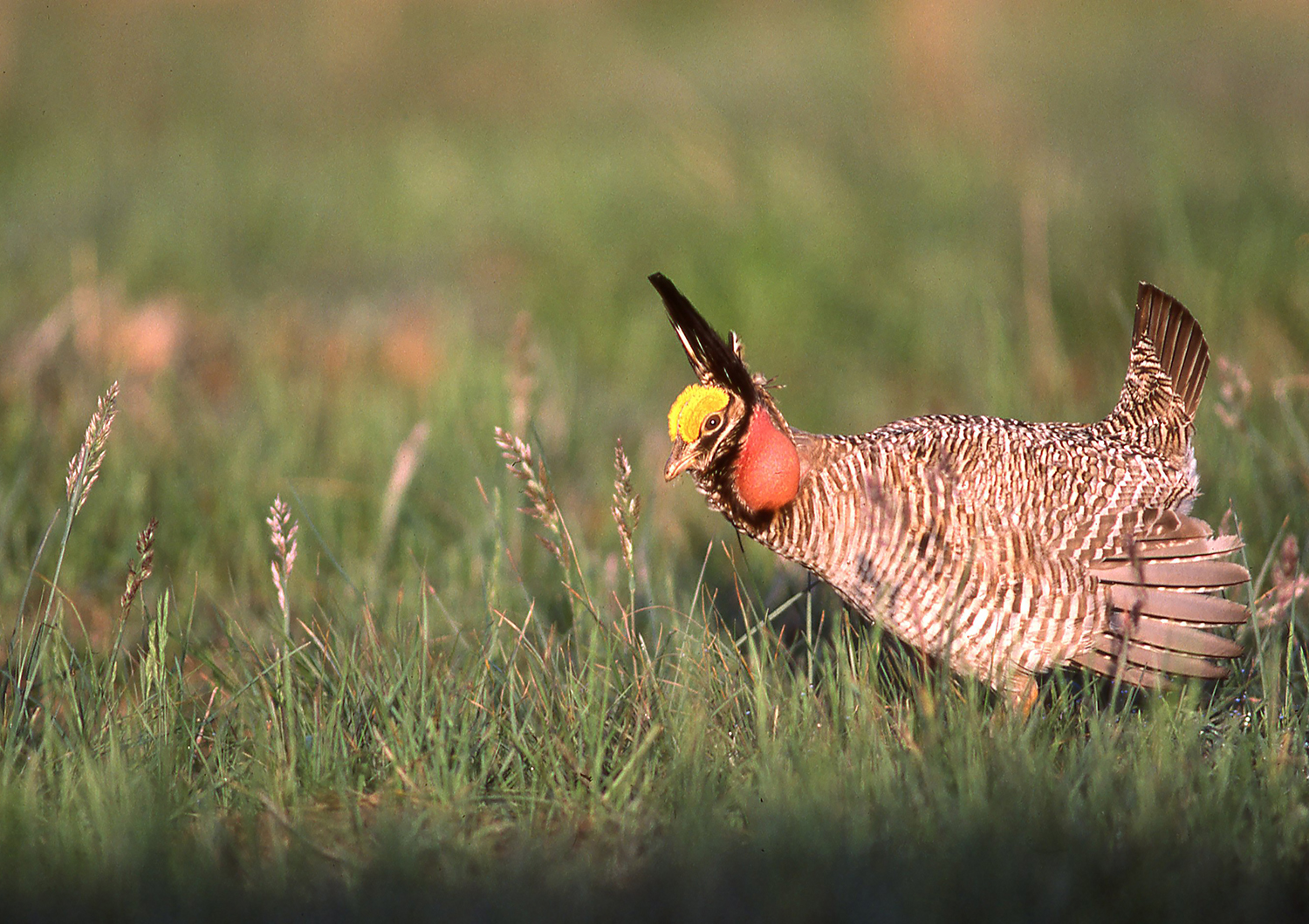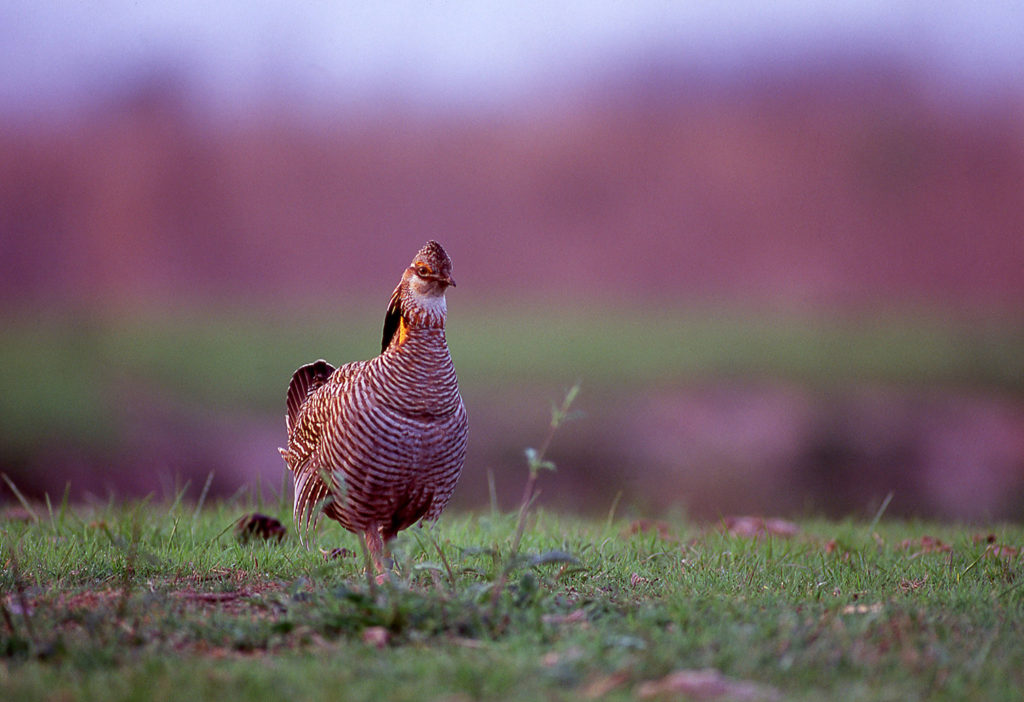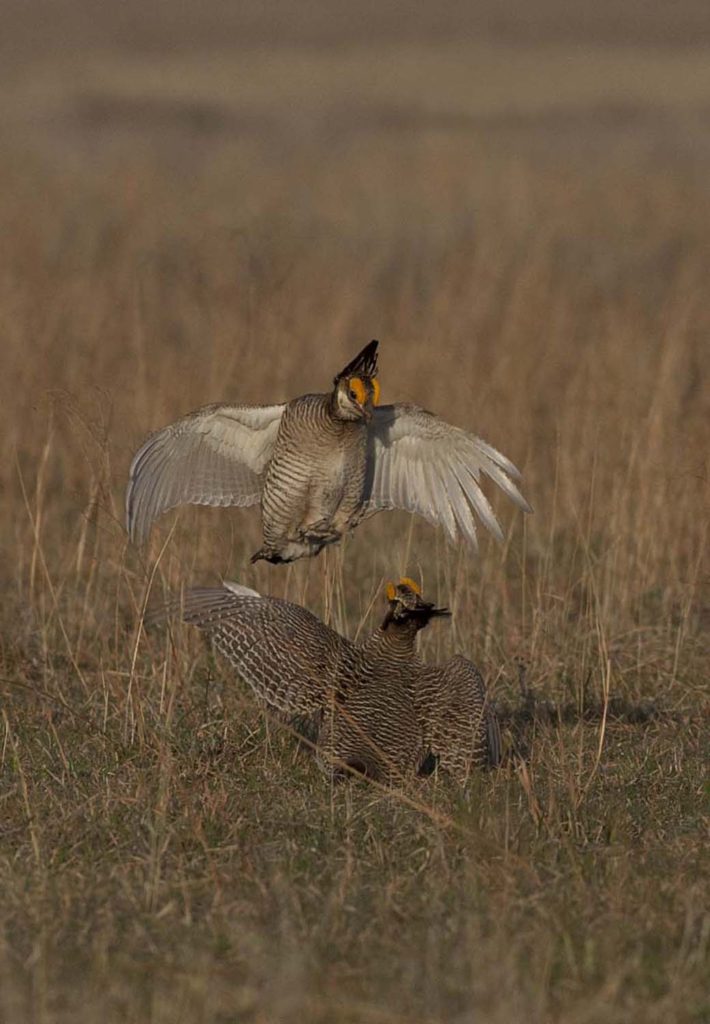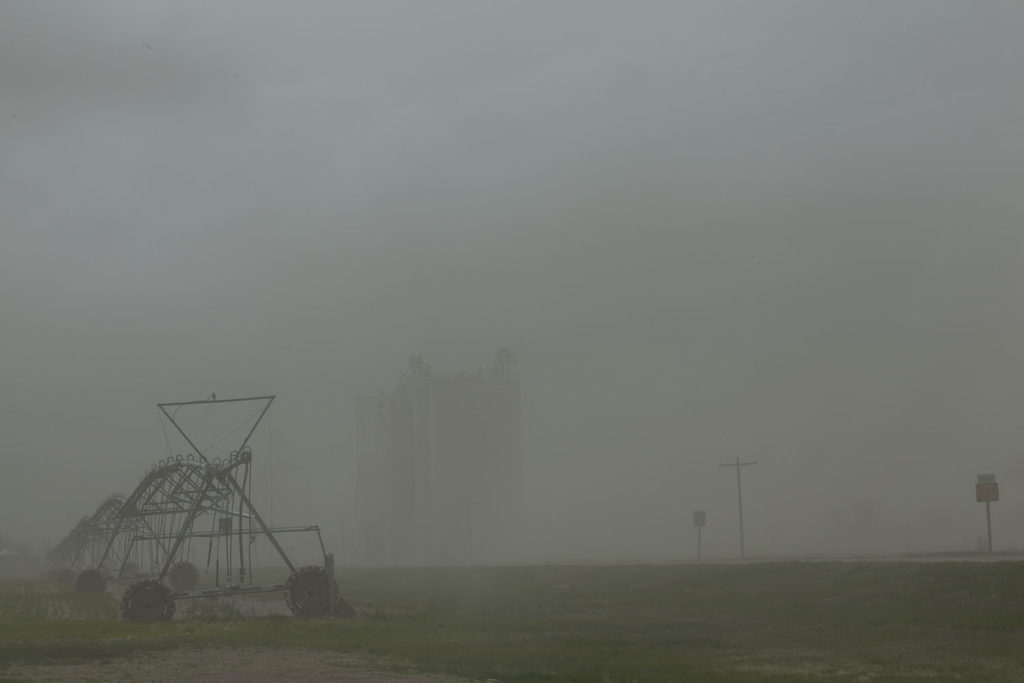
A lesser prairie chicken male displaying on a communal lek in the sandsage prairie of southern Kansas. (Copyright 1980 by Chris Madson, all rights reserved.)
IT’S NOT A BIRD WITH A BIG FAN CLUB. NOT A POP STAR LIKE THE BALD EAGLE OR WHOOPING CRANE OR EVEN THE EASTERN bluebird.
Not that it lacks charisma. For more than a month every spring, the males of the species gather at traditional sites for a dance competition to decide who will sire the next generation. The strange, other-worldly trilling and cackling can be heard a mile away on a quiet morning, and the flamenco steps and pirouettes are so beguiling that they were imitated by Plains Indians in their ceremonials. The males have feathered tufts they raise like antlers, plumb-colored sacs of bare skin they inflate during their displays, yellow combs over their eyes— altogether a striking combination.
I suspect the problem with their public relations isn’t what they are but where they live. They have adapted to survive— and thrive— on one of the most challenging landscapes in North America, the sun-scalded, wind-whipped expanses of the southern Great Plains. It’s one of the Rodney Dangerfields of American ecosystems, a land that gets no respect, so it comes as no surprise that the specialized animals living there get little more.
The bird is known to science as the “lesser” prairie chicken to separate it from its cousin, the “greater” prairie chicken, which was one of the first game birds settlers from northern Europe encountered when they hit the beach in New England.

Perhaps the rarest bird in North America, the Attwater’s prairie chicken clings to a precarious existence on the last scraps of coastal prairie along the Texas Gulf coast. (Copyright by Chris Madson 2016, all rights reserved.)
One subspecies of the greater prairie chicken lived in the grassy openings on and near the Atlantic coast. The earliest colonists there had many names for it, but students of natural history called it the heath hen. It had the poor luck to stand in the way of some of the earliest and most intense European settlement— by 1830, it had disappeared from the mainland, and by 1932, it was extinct.[i] [ii] A second subspecies, the Attwater’s prairie chicken was once abundant along the Gulf coast of Texas and southwestern Louisiana. It is now one of the most profoundly endangered species in North America with somewhere around 100 birds left in the wild.[iii]
The lesser prairie chicken was probably the last of America’s prairie grouse to be introduced to the scientific community, simply because it lived in a place that did not yield easily to White exploration or settlement. In 1873, it was classified as a subspecies of the greater prairie chicken, but, by 1885, taxonomists had examined the bird and its behavior more carefully and decided it was its own species: Tympanuchus pallidicinctus, Greek for the “pale-belted drummer” in recognition of the air sacs it uses to call during spring courtship and the fact that it is generally lighter in color than greater prairie chickens.
No one will ever know how many lesser prairie chickens there were before the first Europeans arrived. One authority has estimated that there may have been as many as two million in Texas alone before the turn of the last century.[iv] The recollections of men who hunted the High Plains in those days left a more personal impression of the abundance of the species. Walter Colvin, an amateur ornithologist and avid bird hunter, made several trips from his home in northeastern Kansas to the far southwestern corner of the state in pursuit of what was then a little-known species.
“It was a cold October day in 1906,” he remembered, when his party pulled into a farm in southwestern Kansas, having heard that “there were a ‘few’ chickens in a cane and kaffir corn field a quarter of a mile east. . . . Such a sight I have never seen before nor since,” he wrote, years later. “Chickens were flushing everywhere, and droves of fifty to a hundred would take off down the corn rows, sounding like a moving avalanche as they touched the blades of corn. . . . Mr. Ward and I estimated that there were from three thousand five hundred to four thousand chickens in this one field, a sight never to be forgotten.” A nearby farmer never allowed shooting on his place and planted a field especially for game birds. “In the fall 1904,” Colvin reported, “my brother estimated that he saw in a single day fifteen to twenty thousand chickens around this one grain field.”
Colvin and his friends came back for years to relive that experience, but as he packed to head home after a hunt in 1913, Colvin thought back to his first visits with regret. “I realized with a shudder that we were nearing the sunset life of the king of upland game birds. The decrease in their numbers is not due so much to the gunners, as gunners are few per capita in those parts, but is due largely to the cutting up of this vast wilderness into small farms.”
Colvin mulled that over as he and his hunting partner drove east into the night at the end of their hunt that fall. In an article he wrote the following winter, he remembered the conversation:
“’There will be plenty of chickens here ten years from now,’ Ralph said after awhile.
“’You’ll be lucky to find a few chickens to shoot five years from now,’ I replied, and that is the truth.”[v]

Two male lesser prairie chickens fight for the right to mate with hens that will eventually join them on the lek. (Photo copyright 2014, Chris Madson, all rights reserved.)
In the decades that followed Colvin’s last visit, populations of lesser chickens ebbed and flowed with the fickle patterns of rain on southern plains, fading during drought, recovering with moisture, but never achieving the peaks they’d known before the plow. During the Dust Bowl, a manmade ecological catastrophe of Biblical proportions, lessers almost disappeared in Kansas, southeastern Colorado, and eastern New Mexico. They recovered slightly in the wetter years of the 1940s, then collapsed again in the droughts of the 1950s.[vi] Weather was the obvious driving force behind the wild fluctuation in numbers, but the long-term downward trend was driven by that all-too-familiar cause: the steady loss of habitat.
By 1980, some experts in the field estimated that the lesser prairie chicken had disappeared from ninety-two percent of its pristine range.[vii] Estimated population was said to have declined even more— by ninety-seven percent[viii]— an indication that the habitat the chickens still occupied was, for one reason or another, less than ideal.
The collapse was duly noted by wildlife professionals. In 1973, the U.S. Fish and Wildlife Service’s “Threatened Wildlife of the United States” had this to say about the lesser prairie chicken: “much reduced or extirpated from large portions of its former range. . . . Decreasing and vulnerable.”[ix] In spite of that gloomy assessment, the lesser chicken was not included in the list of “threatened” or “endangered” species established under provisions of the Endangered Species Act of 1973. State wildlife agencies managed to set aside a few tracts of native grassland on the bird’s behalf, but the general trend of neglect— and loss— continued.
In 1995, the Biodiversity Legal Foundation filed a petition under the authority of the federal Endangered Species Act, demanding that the Fish and Wildlife Service list the lesser prairie chicken as “threatened.” The Service concluded that the listing was ”warranted but precluded by other higher priority listing actions.”[x]
Legal confrontations between various environmental groups and the Fish and Wildlife Service continued until 2014, when the Service announced that the lesser chicken would be given “threatened species status.” That ruling led to another court battle between the Service and several counties in New Mexico that claimed the listing was “unlawful.” The federal district court in west Texas sided with the counties, and the lesser chicken was summarily “delisted” in 2015.[xi]
Even more legal action ensued— finally, in the fall of 2019, the Fish and Wildlife Service agreed to revisit the listing decision and announce its finding by May 26, 2021.[xii]
While the status of the lesser chicken is endlessly debated in court and federal offices, the bird continues to lose habitat. According to researchers with the Defenders of Wildlife, 800,000 acres of chicken habitat have been plowed under for cropland in the five years since the species was delisted. Another 19,000 acres have been invaded by oil and gas or wind energy development.[xiii]
The lesser chicken isn’t alone alone in feeling the effect of disappearing grasslands on the southern plains. The scaled quail is a bird of the Chihuahuan desert. The northern edge of its habitat overlaps most of the lesser chicken’s range. Scaled quail are known to boom and bust with changes in rainfall, but in the last sixty years, the busts have outstripped the booms— according to the national Breeding Bird Survey, scaled quail numbers in the U.S. have dropped fifty percent since 1966.[xiv]
The Harris’s sparrow winters on the high prairie of the southern plains. I first met representatives of the species in the mid-1970s as I hunted pheasants in the sandhills south of the Arkansas River in southern Kansas. They were the most common songbird in the native plum thickets in those days, a dash of bright call notes and curiosity that relieved the tedium of a gray January afternoon. Now, forty years later, the U.S. Fish and Wildlife Service lists the species as a “bird of conservation concern.” Estimates of their population have dropped by more than sixty percent since 1970.[xv]
The grasshopper sparrow is another resident of the southern prairie that has come on hard times in the last fifty years. Like the Harris’s sparrow, it’s considered a “bird of conservation concern” with population declines of nearly seventy percent since 1970.[xvi]
The chestnut-collared longspur winters on the southern plains and has suffered even greater losses. The Canadians have listed it as “threatened;” the International Union for the Conservation of Nature considers it “near threatened” across its range, and, in the U.S., it’s classified as another “bird of conservation concern.” Its numbers have dropped eighty-five percent since 1970.[xvii]
IN THE 1880S, WE CAME IN OUR TENS OF THOUSANDS TO THE GREAT PLAINS, ARMED WITH ALL THE MIRACLES of modern technology— John Deere’s steel plow, Dan Halladay’s self-regulating windmill, Joseph Glidden’s barbed wire— and driven by the boundless hubris of American expansionism. As it happened, we arrived at the beginning of a miraculous series of wet years, a period that allowed the railroad’s real estate boosters to sell the pernicious myth that rain followed the plow on the grasslands. What followed was poignantly described by an observer of farming on the plains in 1902:
“From the 98th meridian west to the Rocky Mountains there is a stretch of country whose history is filled with more tragedy . . . than perhaps any other equal expanse of territory within the confines of the Western Hemisphere. . . . As the territory bordering upon it became more thickly settled and the pressure for land became ever fiercer, the line of settlements encroached more and more upon this stretch of apparently worthless soil. This line of social advance rose and fell with rain and drouth, like a mighty tide beating against the tremendous wall of the Rockies. And every such wave left behind it a mass of human wreckage in the shape of broken fortunes, deserted farms and ruined homes.”[xviii]
The wave advanced in the 1880s and broke in the drought of the 1890s. It advanced again during the wet years in the early decades of the twentieth century and broke with a crash heard around the world in the Dust Bowl of the 1930s. It advanced during the war years and broke in the drought of 1946-1956. It advanced in the 1970s and broke again in the drought of the early 1980s. And again in the great drought of the millennium from 1998-2014. Now, in the spring of 2021, the entire state of New Mexico and parts of west Texas are on the ragged edge of yet another drought disaster.[xix]

The Kanorado, Kansas, grain elevator and a nearby center pivot irrigation system during an April dust storm. Eighty years after the great drought of the 1930s, dust still blows in the Dust Bowl. (Photo copyright 2015 by Chris Madson, all rights reserved)
The great antidote to drought on the plains was Frank Zybach’s center-pivot irrigation system, a pipe on wheels tethered to a well that pumped groundwater out onto the field. The southern and central plains sat on a natural underground reservoir that held as much water as Lake Erie. At last, it seemed, farmers could make their own rain.
At least as long as the aquifer lasted. After two generations of intense pumping, shallower areas of the Ogallala Aquifer in the Texas panhandle are on the verge of being depleted; surface flows in major rivers like the Arkansas and Platte have dwindled, and many smaller springs and ephemeral creeks have dried up. Some operators are already planning for a time when there is no more groundwater for irrigation.
The deepening hot, dry conditions on the plains have increased the risk of catastrophic wildfire. Between 2006 and 2018, major fires burned 4.4 million acres on the southern prairie. In March of 2016, a single fire in southwestern Kansas consumed 663,000 acres in just two days.[xx]
And what does the future hold? Average annual temperatures in the southern Great Plains are expected to increase by 3.6 to 5.1 degrees Fahrenheit by the middle of this century and 4.4 to 8.4 degrees by 2200. Researchers expect thirty to sixty more days over 100 degrees each year by that time. They predict drier summers with fewer, heavier storms.[xxi] In short, the weather will be getting worse for agriculture in the region, not better.
The residents of the southern plains seem to face a common fate, whether they’re lesser prairie chickens . . . or farmers. As yet, relatively few outsiders have shown much concern. When the nation considers the effects of climate change, fires in California and hurricanes on the Gulf coast claim the spotlight, and, when the conversation turns to rare wildlife, attention falls on species with more star power like the gray wolf or the California condor. The great American grasslands still get little respect.
Ecologists who pay attention to such things are cautiously optimistic that the Fish and Wildlife Service will relist the lesser prairie chicken. Even if that happens, I doubt that it will result in a sudden outpouring of support for the bird, the prairie, or the people who live there. I hope that a listing will, at the very least, channel some desperately needed funding into the region.
Because it’s abundantly clear that the way we’ve used the southern grasslands over the last 150 years is unsustainable. It’s been bad for prairie chickens and not much better for people. Before another wave of disaster crashes down on the plains, before another Dust Bowl ravages its people and its wildlife, we need to find a way to live with this land, not on it. Helping the lesser chicken would be a good start.
————-
[i] Gross, Alfred O., 1928. The Heath Hen. Boston Society of Natural History, 6(4).
[ii] Johnson, Jeff, et al, 2011. Greater Prairie-Chicken in Birds of the World, Cornell Lab of Ornithology. https://birdsoftheworld.org/bow/species/grpchi/cur/introduction. Accessed April 18, 2021.
[iii] Anon., May 15, 2020. Good News: We Are Saving a Local Bird from Extinction. Houston Zoo Blog. https://www.houstonzoo.org/blog/good-news-we-are-saving-a-local-bird-from-extinction/. Accessed April 18, 2021.
[iv] Crawford, John A., et al,, 1980. Status, problems, and research needs of the lesser prairie chicken. Proceedings of the Prairie Grouse Symposium, September 17-18, 1980. Oklahoma State University, OK. https://shareok.org/handle/11244/299331. Accessed April 19, 2021.
[v] Colvin, Walter S., 1914. The lesser prairie hen. Outing 63: 608-614. https://babel.hathitrust.org/cgi/pt?id=mdp.39015070321065&view=1up&seq=8. Accessed April 22, 2021.
[vi] Crawford, 1980, op cit.
[vii] Taylor, Maple A. and Fred S. Guthery, 1980. Status, Ecology, and Management of the Lesser Prairie Chicken. USDA Forest Service General Technical Report RM-77.
[viii] Crawford, 1980, op cit. https://babel.hathitrust.org/cgi/pt?id=mdp.39015070321065&view=1up&seq=632. Accessed April 19, 2021.[ix] Office of Endangered Species and International Activities, 1973. Threatened wildlife of the United States. U.S. Government Printing Office, Washington, D.C. https://ia802708.us.archive.org/22/items/threatenedwildli00unit/threatenedwildli00unit.pdf. Accessed April 20, 2021.
[x] U.S. Fish and Wildlife Service, 2014. Endangered and Threatened Wildlife and Plants: Determination of Threatened Status for the Lesser Prairie-Chicken. Federal Register 79(69): 19974-19975.
[xi] Junell, Robert, 2015. Order granting plaintiffs’ motion for summary judgment & order granting in part and denying in part defendants’ motion for summary judgment. United States District Court, Western District of Texas, Midland-Odessa Division, September 1, 2015. https://www.heartland.org/_template-assets/documents/publications/District%20court%20decision%20delisting%20lpc.pdf. Accessed April 20, 2021.
[xii] Contreras, Rudolph, 2019. Stipulated settlement agreement. United States District Court for the District of Columbia, September 12, 2019. https://www.biologicaldiversity.org/species/birds/lesser_prairie_chicken/pdfs/Lesser-Prairie-Chicken-Stipulated-Settlement-Agreement.pdf. Accessed April 20, 2021.
[xiii] Evans, Michael, 2021. Lesser prairie-chicken habitat changes since court delisting: Satellite and government data show extensive habitat loss. Defenders of Wildlife, Washington, D.C. https://defenders-cci.org/publication/lpc_habitat_loss/. Accessed April 20, 2021.
[xiv] Anon, nd. North American Breeding Bird Survey. Patuxent Wildlife Research Center, Laurel, MD. https://www.mbr-pwrc.usgs.gov/. Accessed April 21, 2021.
[xv] Anon, nd. Species conservation profiles: Harris’s Sparrow. North American Bird Conservation Initiative, Washington, D.C. https://partnersinflight.org/species/harriss-sparrow/. Accessed April 21, 2021.
[xvi] Anon, nd. Species conservation profiles: Grasshopper Sparrow. North American Bird Conservation Initiative, Washington, D.C. https://partnersinflight.org/species/grasshopper-sparrow/. Accessed April 21, 2021.[xvii] Anon, nd. Species conservation profiles: Chestnut-collared longspur.. North American Bird Conservation Initiative, Washington, D.C. https://partnersinflight.org/species/chestnut-collared-longspur/. Accessed April 21, 2021.
[xviii] Simons, A.M., 1902. The American Farmer. Charles H. Kerr & Company, Chicago, IL. https://digital.library.pitt.edu/islandora/object/pitt%3A31735066247606/viewer#page/4/mode/2up. Accessed April 22, 2021.
[xix] Anon, 2021. Drought update for the southern plains. National Oceanic and Atmospheric Administration, Washington, D.C. https://www.drought.gov/drought-status-updates/drought-update-southern-plains-dews-0. Accessed April 22, 2021.
[xx] Lindley, Todd T., et Al., 2019. Megafires on the southern Great Plains. Journal of Operational Meteorology 7(12: 164-179. https://objects-us-east-1.dream.io/nwafiles/jom/articles/2019/2019-JOM12/2019-JOM12.pdf. Accessed April 22, 2021.
[xxi] Bartush, Bill, et al, 2018. Southern Great Plains. In Impacts, Risks, and Adaptation in the United States: Fourth National Climate Assessment, Volume II. U.S. Global Change Research Program, Washing, D.C. https://nca2018.globalchange.gov/chapter/23/. Accessed April 22, 2021.
Leave a Reply
You must be logged in to post a comment.